[译林版]六年级“一般过去时”指导课件
- 格式:ppt
- 大小:1.73 MB
- 文档页数:11
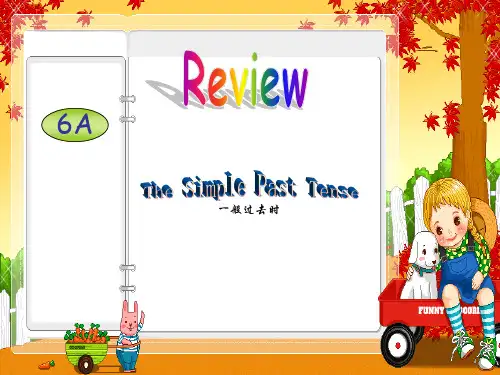
![[最新]牛津译林版六年级英语上册Unit 4 Then and now--一般过去时.ppt](https://uimg.taocdn.com/c1f25beb767f5acfa0c7cd8f.webp)
![[译林版] 一般过去时 讲义课件](https://uimg.taocdn.com/a63a815acd1755270722192e453610661fd95a75.webp)
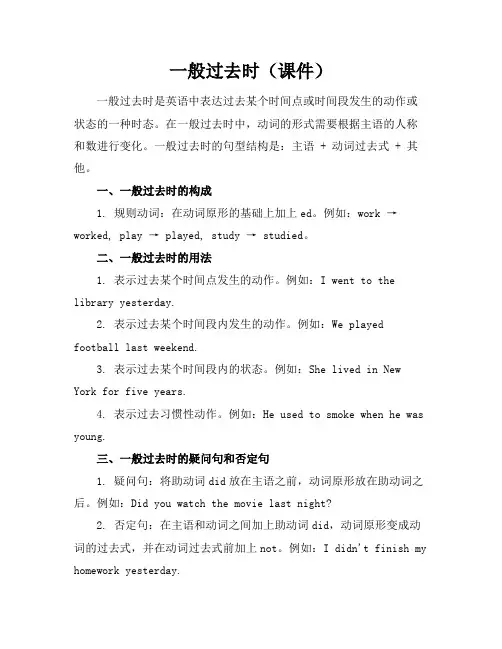
一般过去时(课件)一般过去时是英语中表达过去某个时间点或时间段发生的动作或状态的一种时态。
在一般过去时中,动词的形式需要根据主语的人称和数进行变化。
一般过去时的句型结构是:主语 + 动词过去式 + 其他。
一、一般过去时的构成1. 规则动词:在动词原形的基础上加上ed。
例如:work → worked, play → played, study → studied。
二、一般过去时的用法1. 表示过去某个时间点发生的动作。
例如:I went to the library yesterday.2. 表示过去某个时间段内发生的动作。
例如:We playedfootball last weekend.3. 表示过去某个时间段内的状态。
例如:She lived in New York for five years.4. 表示过去习惯性动作。
例如:He used to smoke when he was young.三、一般过去时的疑问句和否定句1. 疑问句:将助动词did放在主语之前,动词原形放在助动词之后。
例如:Did you watch the movie last night?2. 否定句:在主语和动词之间加上助动词did,动词原形变成动词的过去式,并在动词过去式前加上not。
例如:I didn't finish my homework yesterday.四、一般过去时的特殊用法1. 过去进行时:表示过去某个时间点正在进行的动作。
例如:What were you doing at 8 o'clock last night?2. 过去完成时:表示在过去某个时间点之前已经完成的动作。
例如:I had finished my work before he came.3. 过去完成进行时:表示在过去某个时间点之前一直在进行的动作。
例如:She had been waiting for two hours when he finally arrived.一般过去时(课件)一般过去时是英语中表达过去某个时间点或时间段发生的动作或状态的一种时态。
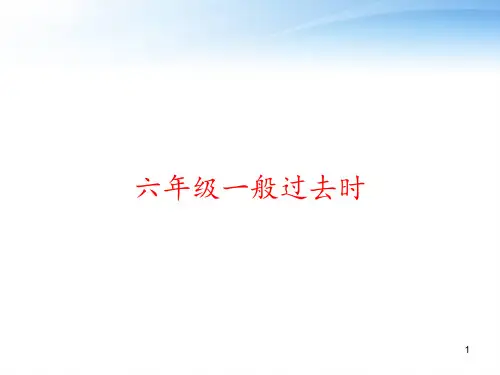
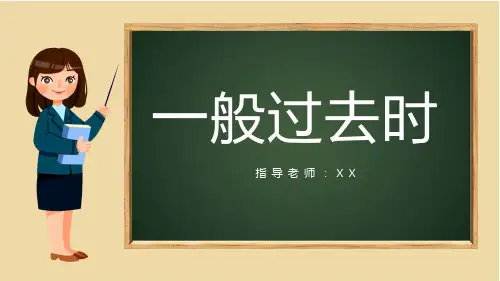

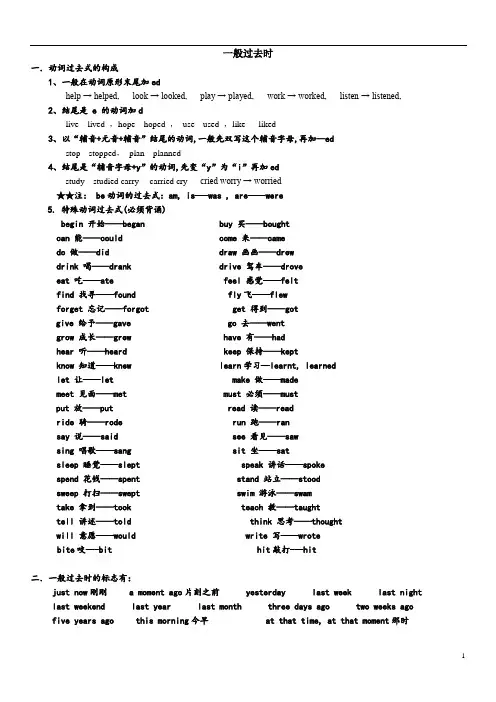
一般过去时一.动词过去式的构成1、一般在动词原形末尾加edhelp → helped, look → looked, play → played, work → worked, listen → listened,2、结尾是 e 的动词加dlive---lived ,hope---hoped ,use---used ,like --- liked3、以“辅音+元音+辅音”结尾的动词,一般先双写这个辅音字母,再加—edstop---stopped,plan---planned4、结尾是“辅音字母+y”的动词,先变“y”为“i”再加edstudy---studied carry ---carried cry --- cried worry → worried★★注: be动词的过去式:am, is---was , are----were5. 特殊动词过去式(必须背诵)begin 开始——began buy 买——boughtcan 能——could come 来——camedo 做——did draw 画画——drewdrink 喝——drank drive 驾车——droveeat 吃——ate feel 感觉——feltfind 找寻——found fly飞——flewforget 忘记——forgot get 得到——gotgive 给予——gave go 去——wentgrow 成长——grew have 有——hadhear 听——heard keep 保持——keptknow 知道——knew learn学习—learnt, learnedlet 让——let make 做——mademeet 见面——met must 必须——mustput 放——put read 读——readride 骑——rode run 跑——ransay 说——said see 看见——sawsing 唱歌——sang sit 坐——satsleep 睡觉——slept speak 讲话——spokespend 花钱——spent stand 站立——stoodsweep 打扫——swept swim 游泳——swamtake 拿到——took teach 教——taughttell 讲述——told think 思考——thoughtwill 意愿——would write 写——wrotebite咬---bit hit敲打---hit二.一般过去时的标志有:just now刚刚 a moment ago片刻之前 yesterday last week last night last weekend last year last month three days ago two weeks agofive years ago this morning今早 at that time, at that moment那时三.一般过去时的构成1.含有be动词的一般过去时(1) 肯定句:主语+was/were+其他成分My book was there just now 我的书刚刚在那儿的。
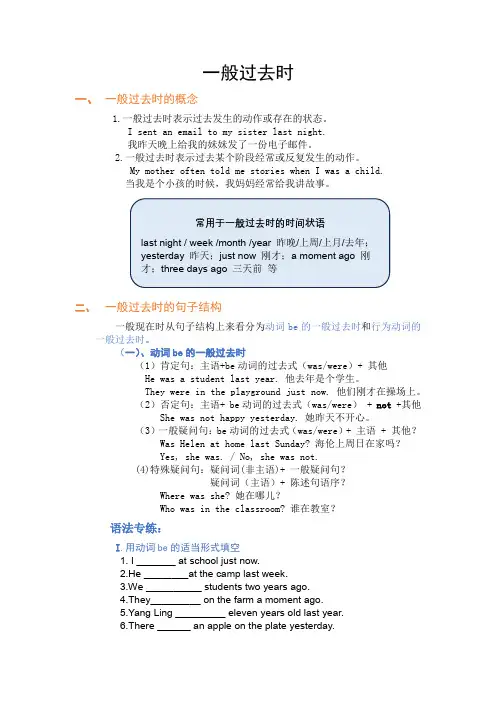
一般过去时一、一般过去时的概念1.一般过去时表示过去发生的动作或存在的状态。
I sent an email to my sister last night.我昨天晚上给我的妹妹发了一份电子邮件。
2.一般过去时表示过去某个阶段经常或反复发生的动作。
My mother often told me stories when I was a child.当我是个小孩的时候,我妈妈经常给我讲故事。
二、一般过去时的句子结构一般现在时从句子结构上来看分为动词be的一般过去时和行为动词的一般过去时。
(一)、动词be的一般过去时(1)肯定句:主语+be动词的过去式(was/were)+ 其他He was a student last year. 他去年是个学生。
They were in the playground just now. 他们刚才在操场上。
(2)否定句:主语+ be动词的过去式(was/were) + not +其他 She was not happy yesterday. 她昨天不开心。
(3)一般疑问句:be动词的过去式(was/were)+ 主语 + 其他? Was Helen at home last Sunday? 海伦上周日在家吗?Yes, she was. / No, she was not.(4)特殊疑问句:疑问词(非主语)+ 一般疑问句?疑问词(主语)+ 陈述句语序?Where was she? 她在哪儿?Who was in the classroom? 谁在教室?语法专练:I.用动词be的适当形式填空1. I _______ at school just now.2.He ________at the camp last week.3.We __________ students two years ago.4.They_________ on the farm a moment ago.5.Yang Ling _________ eleven years old last year.6.There ______ an apple on the plate yesterday.7.There ________ some milk in the fridge last Sunday.8.The mobile phone_______ on the sofa yesterday evening.9.Helen and Nancy _______good friends.10.Yesterday______the first of June. All the students ______ excited. II.句型转换1. It was exciting. (改为一般疑问句并作肯定回答)——__________ _________ _______?——_________, _________ __________.2.They were in the playground. (改为否定句)They _________ in the playground.3.All the students were very excited. (改为一般疑问句并作否定回答)——_________ _________ _______ very _______?——_________,_________ _________.4. Jack was 14 years old last year. (对画线部分提问)_________ _________ _______ Jack last year.(二)、行为动词的一般过去时一般过去时中,动词要用过去式,行为动词有规则和不规则变化。

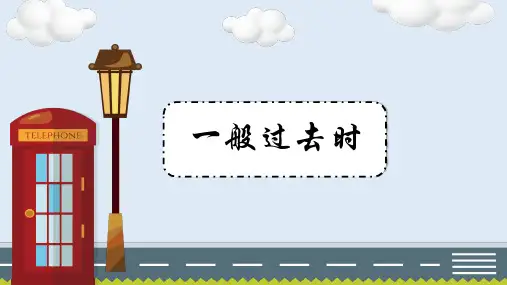
一般过去时重点知识讲解与练习20232024学年牛津译林版英语六年级下册含义:主要用来表示特定过去时间中一次完成的动作或一次存在的状态,也可表示过去存在的状态。
例:We visited the factory last Friday.He left ten minutes ago.She taught us English when I was fifteen.时间标志词:yesterday, the day before yesterday, last week/month/year, just now, a moment ago, long long后+not, 即wasn't/weren’t; 变为疑问句时,把be动词提前。
例:I was in the library last Sunday.She was not at home when I called her just now.Were you in England in 2020? Yes, I was./ No, I wasn’t.动词过去式变化规则⑴be动词的过去式:was和were。
其中was是__is___和___am__的过去式,were是__are__的过去式。
⑵规则动词过去式的构成:一般在动词末尾加ed。
【例】notice→noticed shout→shouted enter→entered push→pushed②以不发音e结尾的动词末尾只加d。
【例】love→loved decide→decided die→died③结尾是“辅音字母+y”的动词。
先将y变为i,再加ed。
【例】study→studied carry→carried hurry→hurried④末尾只有一个辅音字母的重读闭音节,先双写该辅音字母,再加ed。
【例】stop→stopped plan →planned shopshopped⑶不规则动词过去式的构成:【课堂练习】1. They were in the garden just now.否定句:一般疑问句:肯定回答:否定回答:根据划线提问:2. My mother washed the dishes last night .否定句:一般疑问句:肯定回答:否定回答:根据划线提问:用一般过去时改写下列句子。
6A project 1 姓名:一般过去式一般过去时:指已经发生过的动作或事件,至今为止这个动作或事件已经停止。
标志词:yesterday,last例I went to Eric’s party last week.助动词:did例Did you go to school yesterday morning?Be动词:was,were 例Was the dog here just now?动词的过去式变形1. +ed(一般动词的过去式直接在动词后面加上ed即可)2.+d(以e结尾动词,过去式直接加上d即可)3.去y+ied(以y结尾,并且y旁边没有元音字母的动词,把y变成i,再加上ed)4.动词的不规则变形(以下为常用动词的不规则变形,要牢记这些动词哦!)【一】时间状语(即标志词)。
一般过去时表示过去发生的动作或存在的状态,恰巧与表示过去的一些时间状语连用。
1.yesterday或以其构成的短语:yesterday morning(afternoon,evening)等;2. 由“last+一时间名词”构成的短语:last night,last year(winter,month,week)等;3. 由“时间段+ago”构成的短语:a moment ago,a short time ago,an hour ago等;4.其它:just now等(含有实义动词的一般过去时态)(1)一般过去时的肯定陈述句:主语+动词过去式+宾语或表语。
He worked in Shanghai ten years ago.(2)一般过去时的否定句:a.主语+didn’t+动词原形+宾语。
(did+not=didn't)He didn't do morning exercises yesterday.(3)一般过去时的一般疑问句:a.Did+主语+动词原形+宾语?Did you study English in1990?肯定回答用“Yes,主语+did.”;否定回答用“No,主语+didn’t.”(含有be动词的一般过去时态)一般过去时的肯定句主语+ was/were + 表语否定句主语+wasn’t/weren’t+表语。